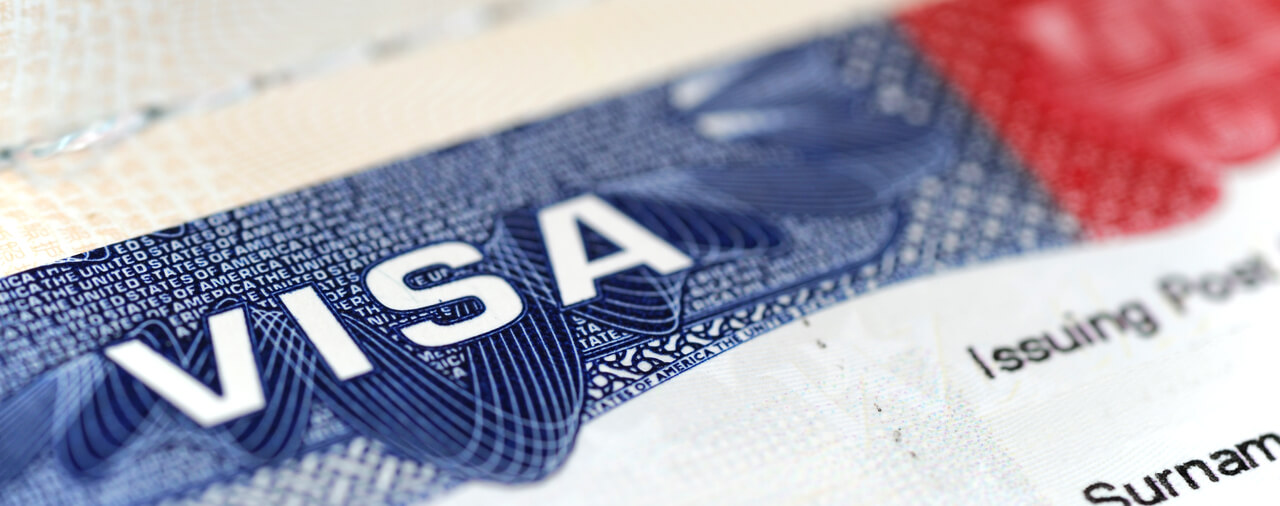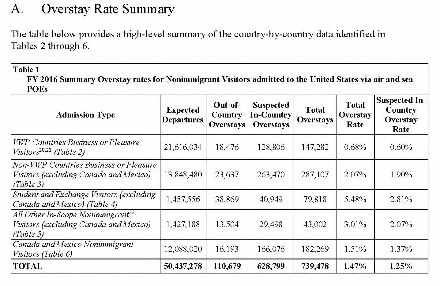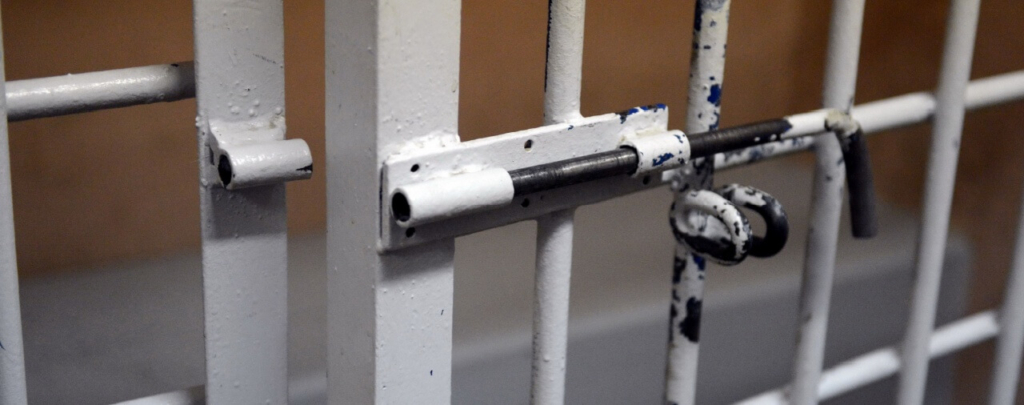Introduction
On May 22, 2017, the Department of Homeland Security (DHS) released its Fiscal Year 2016 Entry/Exit Overstay Report. The report contains information regarding the number of individuals who overstayed their nonimmigrant visas in fiscal year 2016, with detailed breakdowns by category and by country of nationality. In this article, we will examine the statistics and what they mean for future immigration policy debates.
We have uploaded the Fiscal Year 2016 Report [PDF version] and the Fiscal Year 2015 Report [PDF version].
Overview of Statistics
The DHS posted a summary of the overstay rates on page 13 of its 2016 Report. We have reproduced the chart below:
[Click image to view full size]
In fiscal year 2016, there were 50,437,278 “expected departures.” This number corresponds to the number of nonimmigrants who were scheduled to depart the United States at some point in fiscal year 2016. Of these nonimmigrants, 98.53% departed the United States in a timely manner.
Next, we must examine the overstay rates. The chart includes three categories: “total overstays,” “suspected in-country overstays,” and “out-of-country overstays.” Total overstays simply represents the number of nonimmigrants who overstayed in fiscal year 2016. The chart indicates that 739,478 nonimmigrants overstayed, or 1.47% of the total number of nonimmigrants expected to depart. Those are the “total overstays.” However, not all of these aliens remained in perpetuity. 110,679 did eventually depart the United States. These are the “out-of-country overstays.” Minus those 110,679, 628,799 aliens overstayed and did not subsequently depart the United States. The total number of suspected-in-country overstays represented 1.25% of all aliens expected to depart at some point in fiscal year 2016.
The statistics further break down by nonimmigrant type. The bulk of nonimmigrants — and likewise the bulk of total overstays — were nonimmigrant visitors. The most common visitor type was those coming to the United States under the Visa Waiver Program (VWP). Fortunately, the total overstay rate for VWP visitors was only 0.68%. However, due to the sheer number of individuals using the VWP program, this miniscule percentage nevertheless represented 147,282 overstays. The largest number of total overstays were individuals visiting the United States using B1 and B2 visas (excluding Canadian and Mexican non-immigrant visitors). B1/B2 visitors had a total overstay rate of 2.07%, resulting in 287,107 total overstays. Of Canadian and Mexican nonimmigrant visitors, there were 182,269 total overstays and a resulting overstay rate of 1.51%.
Both student and exchange visitors (excluding Canada and Mexico) and all other in-scope nonimmigrants (excluding Canada and Mexico) had higher overstay rates than nonimmigrant visitors. However, due to there having been far fewer nonimmigrants from the non-visitor categories, these overstays represented a relatively small amount of the total. Students and exchange visitors had a stark 5.48% total overstay rate, but interestingly the suspected in-country overstay rate was only 2.81%. This indicates that almost half of the students and exchange visitors who overstayed did subsequently depart the United States.
If one were to just look at the percentage of nonimmigrants who overstayed, the statistics would look encouraging. For example, without seeing the raw numbers, that 98.53% of nonimmigrants departed as scheduled represents, in fact, a very high percentage of compliance with our immigration laws. However, due to the sheer number of individuals who enter the United States as nonimmigrants, the immigration system faces a daunting challenge from even this low overstay rate of 1.25%, which produced 628,799 suspected in-country overstays.
For those who are interested in exploring these statistics in greater depth, the 2016 Overstay Report contains detailed charts by country of nationality for each of the five fields in the overstay rate summary.
Conclusion to the Report
In the conclusion to the report (page 31), the DHS stated that it “has made significant progress in terms of the ability to accurately report data on overstays…” Specifically, the DHS explained that during fiscal year 2016, it was able to use new biometric exit tests and the BE-Mobile law enforcement tool to verify the biographic departure data for a limited number of departures from the United States. Although this applied to only a limited number of cases, the DHS explained that “it is an important first step towards implementing a comprehensive biometric entry and exit system.” The DHS detailed that it will continue working on the biometric-entry exist system during fiscal year 2017.
In welcome news, the DHS stated that it will also continue to release data on overstays annually.
Analysis
Tracking nonimmigrant overstays is a key component of augmenting immigration enforcement. For good reasons, proponents of improving the enforcement of the immigration laws often focus on border security. To that effect, there have been promising signs of improvements in border security in the early months of the Trump Administration [see blog]. Furthermore, there have been promising signs that the Trump Administration’s new enforcement priorities are paying dividends [see blog].
However, with all of the discussion taking place on border security, people often overlook that a significant percentage of persons present in the United States without legal authorization initially entered the country in a lawful manner but then subsequently overstayed. The 9/11 Commission recognized that this is, in and of itself, a national security problem, and it recommended the creation of a comprehensive biometric entry-exit system to track those visitors who overstay. It is worth noting that a biometric entry-exit system has supporters who are not thought of as hardliners on immigration enforcement. For example, we noted on site that Senator Lindsey Graham — a supporter of the failed “Gang of Eight” immigration reform effort from a few years ago — expressed his support for a biometric entry-exit system during his short-lived presidential campaign [see blog].
Section 8(a) of President Donald Trump’s Executive Order 13780 (Mar. 6, 2017) directed the DHS to expedite completion of a biometric entry-exit system [see article]. To this effect, President Trump directed the DHS to provide regular updates on its progress. This provision of President Trump’s Executive Order was overshadowed by its more controversial provisions regarding nationals of six countries designated in section 217(a)(12) of the Immigration and Nationality Act (INA) and refugee travel. However, the creation and comprehensive implementation of a broad and functional biometric entry-exit system could stand to be the most important immigration policy consequence of Executive Order 13780.
As part of a broad immigration reform effort, it will be important for the DHS to continue improving its ability to account for overstays. Furthermore, the Trump Administration must work with Congress to ensure that the DHS receives the funding it needs to continue making progress in this area.






